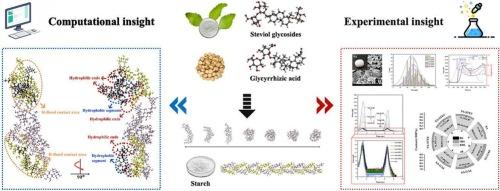两亲性天然甜味剂对淀粉链动态行为的干预机制:计算和实验见解
IF 10.7
1区 化学
Q1 CHEMISTRY, APPLIED
引用次数: 0
摘要
两亲性天然甜味剂(即甜菊糖苷(STE)和甘草酸(GA))已被用于改善各种淀粉产品的质量,其基本特征是前者对后者链动态行为的干预。然而,这些现象及相关机制仍缺乏系统的深入研究。本文采用双温分子动力学模拟结合实验分析的方法,串联研究了甜味剂对六种与淀粉特性密切相关的链动力学行为的干预,包括解卷、移动、长短期重联、重排和解聚。结果表明,STE 和 GA 都能促进淀粉链的开卷和移动,同时也能延缓淀粉链的长短期重新结合和重新排列。此外,在促进链的松解和移动方面,GA 的作用比 STE 更大。特别的是,GA(0 %-40 % w/w)与淀粉共同形成了一种新的微观结构,尤其是在高含量(≥ 20 % w/w)时,它赋予了淀粉极高的硬度(15.50 gf→189.36 gf)和硬化率(2.72 gf/d→17.76 gf/d),同时也为延缓淀粉解聚提供了物理屏障(慢消化淀粉:11.26 %→20.62 %)。这项研究为淀粉/亲水天然甜味剂复合基质的开发提供了数据和理论支持。本文章由计算机程序翻译,如有差异,请以英文原文为准。

Intervention mechanism of amphiphilic natural sweeteners on starch chain dynamic behavior: Computational and experimental insights
Amphiphilic natural sweeteners (i.e. steviol glycosides (STE) and glycyrrhizic acid (GA)) have been adopted to improve the quality of various starchy products, which can fundamentally be characterized as the intervention of the former in the chain dynamic behavior of the latter. However, these phenomena and related mechanisms still lack systematic insights. Herein, dual-temperature molecular dynamic simulations combined with experimental analysis were used to tandemly investigate the intervention of sweeteners in six types of chain dynamic behaviors that are strongly correlated with starch properties, including unwinding, movement, long/short-term reassociation, rearrangement, and depolymerization. The results show that STE and GA both promoted the chain unwinding and movement, and also retarded the chain short/long-term reassociation and rearrangement. Besides, GA exhibited a greater role than STE in facilitating chain unwinding and movement. Peculiarly, GA (0 %–40 % w/w) collaborated with starch to form a new microstructure, especially at high content (≥ 20 % w/w), which endowed starch with exceptionally high hardness (15.50 gf→189.36 gf) and hardening rate (2.72 gf/d→17.76 gf/d), and also placed a physical barrier to retard starch depolymerization (slowly digestible starch: 11.26 %→20.62 %). This work contributes data and theoretical support for the development of starch/amphiphilic natural sweetener composite matrices.
求助全文
通过发布文献求助,成功后即可免费获取论文全文。
去求助
来源期刊

Carbohydrate Polymers
化学-高分子科学
CiteScore
22.40
自引率
8.00%
发文量
1286
审稿时长
47 days
期刊介绍:
Carbohydrate Polymers stands as a prominent journal in the glycoscience field, dedicated to exploring and harnessing the potential of polysaccharides with applications spanning bioenergy, bioplastics, biomaterials, biorefining, chemistry, drug delivery, food, health, nanotechnology, packaging, paper, pharmaceuticals, medicine, oil recovery, textiles, tissue engineering, wood, and various aspects of glycoscience.
The journal emphasizes the central role of well-characterized carbohydrate polymers, highlighting their significance as the primary focus rather than a peripheral topic. Each paper must prominently feature at least one named carbohydrate polymer, evident in both citation and title, with a commitment to innovative research that advances scientific knowledge.
 求助内容:
求助内容: 应助结果提醒方式:
应助结果提醒方式:


